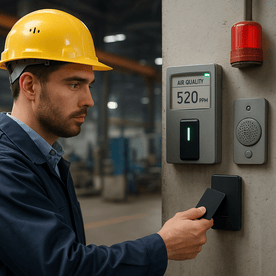
In manufacturing environments where chemicals, fumes, or dust are part of daily operations, air quality isn’t just an EHS issue—it’s a security one.
Many facilities rely on standalone sensors to monitor CO2, VOCs, or gas levels. Others rely on access control to manage who enters restricted zones. But what if those two systems talked to each other?
That’s where real-time integration comes in.
By combining air quality monitoring with your facility’s access control system, you can automate responses, restrict unsafe access, and give your safety team the visibility they need to act fast.
In this post, we’ll walk through how it works, where it’s used, and why it’s quickly becoming a best practice in modern industrial site security.
k
k
Why Air Quality and Access Control Should Work Together
On the surface, air quality and badge readers seem unrelated. One checks environmental data; the other checks credentials. But inside a manufacturing plant, the two are often part of the same safety story.
Imagine this:
A sensor in your paint booth detects a VOC level beyond the safe threshold. The air scrubbers kick in—but two technicians are about to badge into the zone for their shift.
Should they be allowed in?
If your systems aren’t integrated, the door grants access without question. If they are connected, your access control software can automatically:
-
Deny entry until air clears
-
Alert safety supervisors in real-time
-
Log the event for OSHA compliance or post-incident review
-
Trigger signage, lights, or intercom warnings at the entry point
In short, you're not just monitoring air quality—you’re making it actionable.
k
k
Key Use Cases in Manufacturing
Here’s where we see integration making the biggest impact for our clients:
1. Hazardous Material Storage
When storage rooms contain flammable or toxic substances, air quality sensors help detect leaks early. Tying those alerts into access control prevents staff from walking into a hazard unknowingly.
2. Paint, Welding, and Mixing Areas
Zones where volatile organic compounds (VOCs) or fine particulates are common need layered safety controls. Integrated systems allow you to enforce access rules based on real-time exposure levels.
3. Confined Spaces
In areas with limited ventilation—like tanks, silos, or underground service tunnels—access control shouldn’t allow entry until air quality is verified as safe.
4. Shift Change Protocols
When new teams arrive, sensors can check ambient air status and delay access until post-cleanup or ventilation cycles are complete.
k
k
How the Integration Works
Modern access control platforms like those implemented by SSP can link directly with building automation systems, including:
-
Air quality sensors (for VOCs, CO, NO2, particulate matter, etc.)
-
Gas leak detectors
-
HVAC automation
-
Alarm panels and strobes
-
Digital signage or badge reader alerts
When a sensor crosses a threshold, it sends a signal to your access control software. That software then enforces pre-defined rules—like locking specific doors, notifying security, or triggering a sitewide alert if needed.
At SSP, we design these workflows based on your facility's unique risk zones, traffic flow, and compliance needs.
k
k
Benefits Beyond Safety
Integrating air quality sensors with access control isn’t just about checking a compliance box. It also delivers:
✅ Faster Emergency Response
Instead of waiting for someone to escalate an issue manually, your system reacts the moment a reading exceeds safe limits.
✅ Audit Trails for Investigations
You’ll have time-stamped logs of who entered, when, and under what environmental conditions—crucial for root cause analysis or liability defense.
✅ Better Worker Confidence
Employees feel safer knowing the system won’t allow them into a dangerous area without environmental clearance.
✅ Automated Compliance Documentation
Event data can be exported for OSHA, ISO, or EPA inspections—showing proactive safety controls in place.
k
k
A Real-World Approach with SSP
SSP specializes in bringing these integrations to life for manufacturing clients across the Southeast. Our team works alongside your EHS and facility leadership to:
-
Identify high-risk environmental zones
-
Design custom access control workflows
-
Integrate new or existing air quality sensors
-
Build automated triggers for access denial or alerts
-
Provide dashboards, reports, and support for ongoing compliance
It’s not just about selling sensors or badge readers—it’s about creating a smarter, safer, more responsive environment for everyone inside your facility.
k
k
Final Thoughts
As manufacturing environments grow more complex, so does the need for systems that speak the same language. When air quality and access control work together, you can prevent exposure, streamline emergency response, and build a stronger safety culture.
If your current setup is leaving these systems in silos, it may be time for a connected approach.
Curious how this would work in your facility?
Schedule a walkthrough with SSP’s integration team. We’ll help you assess your current systems and design a solution tailored to your plant.


